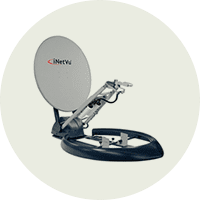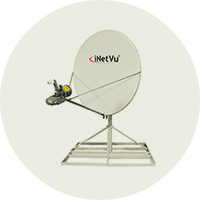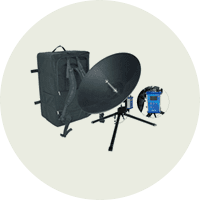ABOUT: C-COM Satellite Systems Inc. is a pioneer and world leader in the design, development, and manufacture of transportable and mobile satellite-based antenna systems. The Company has sold more than 10,000 antenna systems, in over 100 countries, through a dedicated dealer network that provides service to a wide range of vertical markets such as Oil & Gas Exploration, Military Communications, Disaster Management, etc. C-Com’s iNetVu® brand is synonymous with high quality, reliability, and cost-effectiveness. The Company is in late-stage development of a potentially revolutionary Ka-band, electronically steerable, modular, conformal, flat panel phased array antenna. In cooperation with the University of Waterloo, C-COM is engaged in the design of this unique antenna with the intent of providing low-cost, high-throughput mobility applications over satellite for land, airborne and maritime verticals. For additional information please visit www.c-comsat.com

INTERVIEW TRANSCRIPTS:
WSA: Good day from Wall Street. This is Juan Costello, Senior Analyst with the Wall Street Analyzer. Joining us today is Dr. Leslie Klein. Thanks for joining us today there, Dr. Klein.
Dr. Klein: Thanks for inviting me, Juan. Nice to talk to you again. We have not been speaking for a while, but looking forward to your questions.
WSA: Yeah, certainly. So, yeah, please start off by providing an intro of the company for some of our listeners that, they may be new to the story, not caught our previous call, which was about a year ago.
Dr. Klein: C-COM satellite system, as you mentioned, is listed on the Toronto Venture Exchange and on the OTCQB. And we have been in business for the past 27 years. About 25 of those have been public. We raised about $5 million in early 2000 when we went public and we have never gone back. We’ve never raised any additional funds. The company is profitable, has been profitable for most of its 27 years. It also pays dividends. It is debt free and it has about $25 million of working capital. The company is involved in the development, design and manufacturing of Communications on the Pause, which is a satellite term where you can use an antenna system that’s a robotic device, sits on top of a vehicle, you push a button and within a few minutes, it locates any satellites anywhere in the world. And you are able to browse the net and do many other things using this system very much the same way as you would be in downtown New York or wherever there is high speed connectivity. It’s all done through satellite. You have a satellite modem, you have an antenna, and you have a service provider who delivers the connectivity.
The company has sold over 10,000 antennas in the number of years that we’ve been in business. We are quite small, only 35 people, but we have a very long reach. We are active in 105 plus countries in the world. And the way we do that is through integrators and resellers. The company has over 600 integrators and resellers in 105 plus countries. And those are the people who buy the product from us, install them, warranty them and provide support to the customer for them. So essentially, all of our sales go through integrators and resellers. The company has about 40 different products, and we are working on some interesting new technologies in light of the lower orbit satellites that are coming up from Starlink and Amazon, Telesat and many others who are developing constellations, which will change dramatically how the connectivity is going to be made available around the world. And we’ll also make it Communication on the Move, which will be a new business for us because we have been delivering Communication on the Pause, which means that the vehicle had to stop, push a button, find a satellite, connect to the internet, do the connectivity. When finished, you push another button and the antenna stows and you drive away. With the new technology, it’ll be possible to drive and browse the net at high speed pretty much similarly as you see them in aircraft today and on marine vessels. And all of this technology will be available over low earth orbit satellites using electronically-steered antennas, which C-COM has been developing for the past six years.
We are planning to introduce this new product to the market next year. We’ll be manufacturing them in quantities hopefully next year. So that’s a brief introduction for you, Juan.
WSA: Yeah, I appreciate that. And can you bring us up to speed on the most recent news, which is the Q1 and full year results?
Dr. Klein: So Q1 was a very good quarter for us compared to last year where we lost about $176,000 in Q1 2023, but in 2024 we have made about $400,000 after taxes which was a significant improvement. The company still retained the same amount of working capital of about $25 million. And as I mentioned, we paid dividends. Our yield on the dividend for the first quarter was about 3.9%. And the company had sales of $2.6 million in the first quarter which was significantly higher than the 683,000 that we did a year ago. And looking forward, we hope that the company will do just as well in the second quarter as we did in the first quarter or very close, we hope. And again, we expect that the year should be a better year in 2024 than it was in 2023.
WSA: Certainly. And can you discuss the benefits and recent updates there for the newly released Manpac antenna for that product line and what the main applications are?
Dr. Klein: We introduced a backpack antenna what you call a Manpac which can be carried by one person. The whole antenna is carbon fiber. It’s very light, it’s under 25 kilos, and it can be easily carried by one person in a backpack. It assembles within a few minutes without any tools and can find the satellite in 30 or 40 seconds. This antenna has been very popular. We sold about 400 of them. The bulk of it went to SoftBank in Japan for cellular backhaul. But the military is starting to pick up this product, although it is not mil spec, it’s designed for commercial use but it’s a very robust product. A number of militaries around the world started ordering them for their soldiers to be used for instant communication and rapid deployment.
We have recently introduced a larger version of the same antenna, using the same technology for customers who need more bandwidth and who want to travel further into very remote areas with this antenna where you need a larger physical size antenna. So instead of a one meter antenna, this is a 1.3 meter antenna. And again, the first customer that bought it was the US military. So we are hoping that interest in this carbon fiber antenna will be attracting many other militaries. We have sold to several of them in Asia and we expect that we will be selling quite a few of them in the Middle East and in Europe. This antenna is becoming very popular, and it works very well for those people who need this type of connectivity.
WSA: And so what are the key trends, Leslie, that you’re seeing right now in the SATCOM sector?
Dr. Klein: Well, as you know, there has been a very large disruption in the business mainly due to Starlink that introduced the consumer solution using their low earth orbit satellites. The antennas that they are using are Ku band. Our electronic antennas are Ka band, which is the next generation of low earth orbit satellites that are going to be launched by Telesat, Amazon and a number of others. Because the Ka band frequency allows for smaller antennas, less expensive antennas and can deliver much more bandwidth. With this in mind we have started developing a Ka-band phased array antenna about six years ago. As I mentioned, we are in a final phase of manufacturing and testing of this antenna with the hope of selling them next year.
The company has an arrangement with the University of Waterloo where many of our Radio Frequency designers come from. We have an office on the campus of the university where the original antenna design team is located. We have received funding from the Government of Canada for the development of analogue electronic beam forming integrated circuits which are used in the antennas that we are going to be selling. This is a very interesting additional technology development. The electronic antenna market is expected to be a $17 billion market in a very short period and the beam forming integrated circuit market is going to be a $4 billion market. We are looking at opportunities that are definitely much larger than the type of business we are in today and we look forward to getting a good slice of that market very soon.
WSA: Great, So what are the key goals you’re hoping to accomplish over the next three to six months here? And how do you think that your interests align with those of the current shareholders?
Dr. Klein: Well, what we expect in the next three to six months is to finish the manufacturing and environmental testing of the phased array antenna. We are also expected to see first sample of the beam forming integrated circuit that hopefully will be utilized in the next generation of the electronically steered antennas that we will manufacture. We expect our regular business, which is essentially selling the same Communication on the Pause antennas that we have sold over 10,000 of to continue to generate revenue for us in order that we can continue the research and development of the electronically steered antenna, without the need to borrow additional funds.
As I mentioned before, the company is profitable. It has no debt, and it pays dividends. It paid out over $25 million in dividends over the last 48 quarters. I believe personally that the stock is severely undervalued. I own about 40% of the company, and I’ve never sold a share. I’m waiting for an opportunity to drive the price of the shares higher than they are and continue paying dividends to shareholders and deliver new technology and new opportunities in this potentially very large satellite communication market.
WSA: Before we conclude here, why do you believe investors should see CMI as a good investment opportunity today?
Dr. Klein: As I mentioned before, we are a leading edge technology company that is technology-driven. It’s debt-free, pays dividends and is profitable. I believe that there is a huge opportunity for us both in the electronically steered antenna market and the beam forming integrated circuit market to get a good portion of this business and transform this company from an on the pause company (COTP) to an on the move (COTM) antenna manufacturer delivering high speed connectivity into vehicles, boats, planes, and drones with the technology that we are developing. This could be a potential game changer for C-COM, once we start delivering these products to our customers around the world.
WSA: Well, we certainly look forward to continuing to track the company’s growth and report on the upcoming progress. And we’d like to thank you for taking your time to join us again here, Dr. Klein, and update our investor audience. It’s always good to have you on.
Dr. Klein: Thank you very much for the interview, Juan. Much appreciated.



